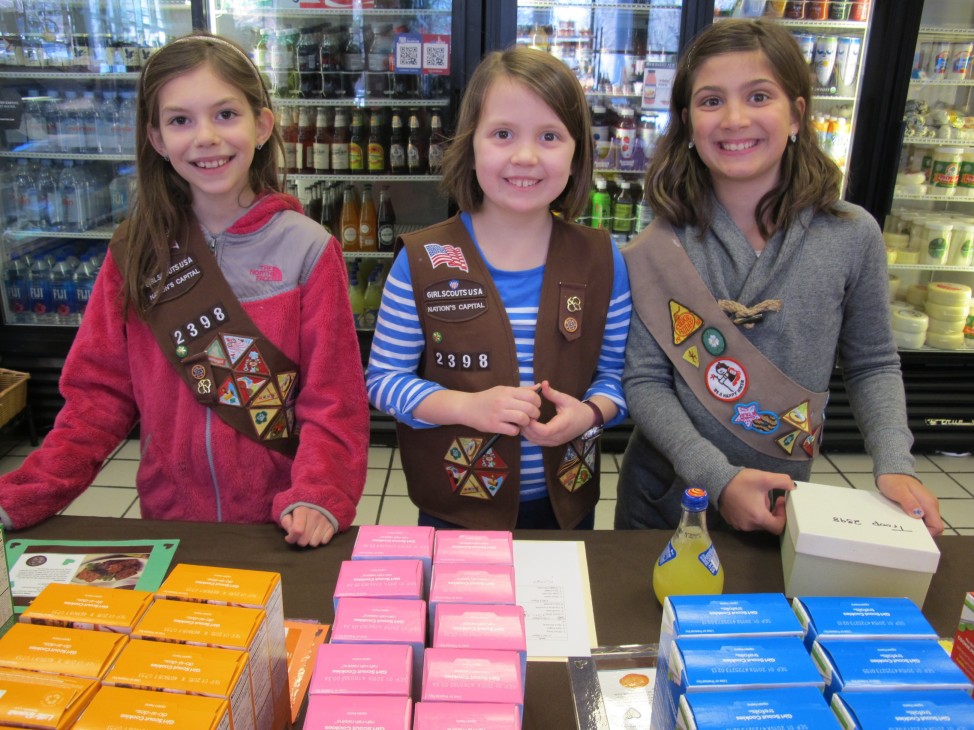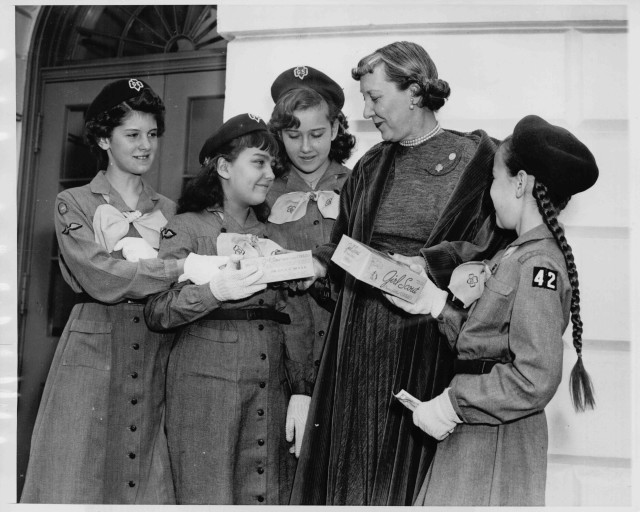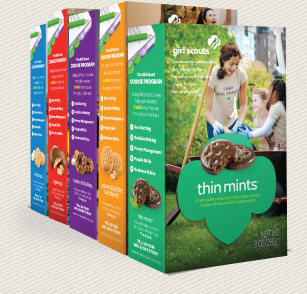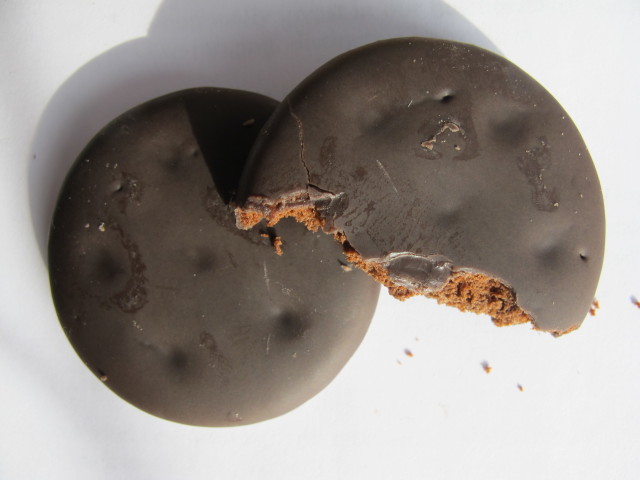
From left, Girl Scout Troop 2398 members Sara Paget, Nora Nowicki and Olivia Shea peddle cookies at a retail shop in Arlington, Va., Feb. 22, 2015. (Carol Guensburg / VOA)
It’s crunch time for Girl Scouts of the USA, with this weekend designated for a major push in its annual cookie sale. Girls nationwide will be out in force – going door to door or operating temporary booths near the entrances of friendly retail shops – to peddle chocolatey Thin Mints, shortbread, peanut butter-filled Tagalongs and other beloved confections.
More than 2 million school-aged American girls are members of the Girl Scouts, an organization that promotes character, outdoor activities, good citizenship, and service to others.
Most of the youth organization’s members, plus 800,000 adults, participate in the decades-old cookie fundraiser. They sell approximately 200 million boxes a year, generating about $800 million in sales. Each of the 112 councils sets its own prices, averaging $4 a box, and its own sales period, which ranges from January into April.
For the first time, the Girl Scouts are selling their cookies online, a move that earned them accolades from Fast Company. The business magazine named the scouts in its Top 10 most innovative nonprofit groups for “showing girls technology is about more than texting.”
Marissa Driscoll, a spokeswoman in the organization’s New York office, said it’s too soon to gauge the impact of online sales.
Digital Cookie sales
A Digital Cookie “finder” app leads customers to booths such as the one set up last Sunday by Troop 2398 at a small market in Arlington, Virginia.
“Would you like to buy some cookies?” asked Olivia Shea, 8, smiling and waving her arm across a display of brightly colored boxes. She stepped off to the side to snack on potato chips.
Nora Nowicki and Lia Musser, both 9, concentrated on making correct change for customer orders. “Count one more time,” Nora urged as they laid down dollar bills they’d just been handed.
As one couple turned to leave with a cookie stash, Basma Paget, mother of 8-year-old Sara Paget, cleared her throat and jerked her head toward the two to extract a response from the girls. Her daughter noticed and elbowed her friends.
“Thank you for buying cookies!” they responded as a chorus.
Money management and people skills are among five key lessons associated with the cookie program. A side panel on each box advertises those skills, including goal setting, decision making and business ethics. (It says nothing about the skills customers develop: portion-control management or, barring that, immediate-gratification rationalization.)
Camp Fire, another national program serving approximately 250,000 youths, touts similar benefits associated with its annual candy sale. That, too, runs in the early months of the year.
Thin Mints shortage
Girl Scout customers who place orders and wait a few weeks for delivery understand delayed gratification. This year, they may face a longer wait than usual. Some areas of the country have experienced a shortage of Thin Mints, the most popular cookie.
“Rest assured that the bakers are working around the clock to ensure that our councils, troops and customers receive their cookie orders in a timely fashion,” the organization said in a statement.

FILE – Troop 288 members Mamie and Ellen Moore present Girl Scout cookies to their aunt, first lady Mamie Eisenhower, at the White House in 1953. They’re joined by other scouts from the Washington, D.C., area. (Girl Scouts of USA)
Demand has been growing since the cookie program’s earliest days.
The program dates back to 1933, when the Girl Scouts of Greater Philadelphia Council sold home-baked cookies at the local utility company for 23 cents a box. Two years later, the Girl Scout Federation of Greater New York got in on the action by peddling commercially prepared cookies in a labeled box. In 1936, the national organization began the licensing process to line up a commercial baker to produce the treats for nationwide sales.
Today, the Girl Scouts organization contracts with two companies – ABC Bakers and Little Brownie Bakers LLC – for a dozen kinds of cookies. Not all are available nationwide.
The cookies reflect dietary trends. This year’s options include two new gluten-free varieties – Toffee-tastic and Trios – and Rah-Rah Raisin, an oatmeal cookie with dried fruit and Greek yogurt-flavored chunks.
National sales, global impact
While the cookies have limited distribution, the Girl Scouts recognize the cookie program’s global impact.
The cocoa in those chocolate-glazed Thin Mints, Samoas and peanut butter-filled Tagalongs comes from “conflict-free,” responsible sources, its website assures.

Boxes of Girl Scout cookies. (Girl Scouts of USA)
“Our bakers are required to provide assurance that cocoa sourced for Girl Scout cookies is child- and slave-labor free,” it says. “… Our bakers are also working with third-party organizations focused on creating a sustainable marketplace that rewards cocoa farmers who prohibit unethical practices.”
The organization has “a responsibility to provide leadership on the topic of slave labor and human trafficking,” it adds. “We are committed to using our powerful voice and brand wherever possible to affect change in this area.
Scouting is about leadership, its executives stress. This weekend, with the focus on sales, girls may be chasing a record set last year by Katie Francis, a 12-year-old from Oklahoma. She sold an eye-popping, stomach-straining 21,477 boxes.
After paying the commercial bakers, all the revenue – average 65 to 75 percent of the retail price – stays with local councils and troops to support activities such as crafts, technology training, service projects, field trips and camping.
As the Girl Scout website says, “Every cookie has a mission: to help girls do great things.”























And the organization will get rich and the troops are left with the crumbs.
Good Job! to all the Brownies and Girl Scouts of America,
when I was selling cookies, in Wichita Kansas, 1958- 1959 the box of cookies were
fifty cents, and our carrier was a box with folded handles which if I recall correctly,
carried 24 boxes of cookies. I do not remember the types except my favorite was the
shortbread.
have fun and be safe, and, God Bless you all
Hi, my comment is that if you put your own girl scout cookie website all over the world, you and your cookies might be a big success all over the world and you could be famous! Well, if you take my advice you could be happy. Good luck! bye.